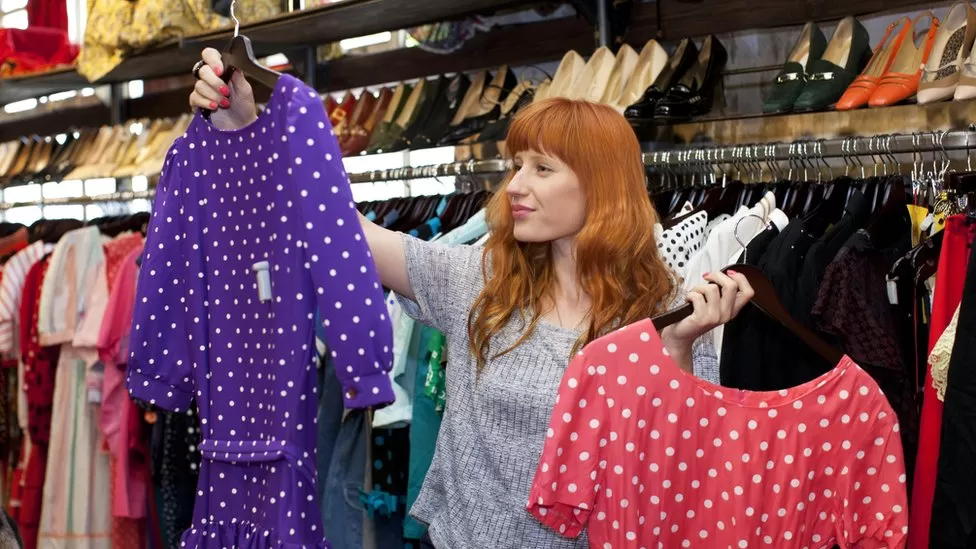Now, some UK brands are being investigated over claims about the sustainability of their fashion lines.
What can you do to reduce your wardrobe’s impact on the planet?
What is fast fashion?
The term describes the quick turnover of fashion trends and the move towards cheap, mass-produced clothing – with new lines constantly released.
Wardrobes are “overflowing with clothes”, argues fast fashion campaigner Elizabeth Cline. Oxfam research suggests the average Briton has 57 unworn items.
What’s the environmental impact of fast fashion?
Producing clothes uses a lot of natural resources and creates greenhouse gas emissions which are responsible for climate change.
Overall, the fashion industry is responsible for 8-10% of global emissions, according to the UN – more than the aviation and shipping combined.
And global clothes sales could increase by up to 65% by 2030, the World Bank suggests.
Most of fashion’s environmental impact comes from the use of raw materials:
- cotton for the fashion industry uses about 2.5% of the world’s farmland
- synthetic materials like polyester require an estimated 342 million barrels of oil every year
- clothes production processes such as dying requires 43 million tonnes of chemicals a year
The industry also uses a lot of water.
Who buys fast fashion?
UK shoppers buy more clothes per person than those in any other country in Europe, according to MPs.
Young people top that list. A recent survey by environmental charity Hubbub found that more than two-fifths of 16 to 24-year-olds buy clothes online at least once a week, compared to 13% on average for other age groups.
How can you reduce your fashion footprint?
The UN has launched the #ActNow Fashion Challenge to highlight how industry and individuals can help improve fashion’s environmental impact.
It says that reducing the fashion industry’s carbon footprint “is key to limiting [global] warming”.
Make clothes more sustainably
Several firms have launched “eco” collections which use organic and recycled materials, including H&M Conscious, Adidas x Parley and Zara Join Life.
But critics argue such collections don’t solve the biggest problem – overconsumption.
“Until brands tackle this issue first and foremost, ‘conscious collections’ by fast fashion brands can only ever be considered greenwashing,” argues Flora Beverley, co-founder of sustainable brand Leo’s Box.
Zara rejected the accusation, telling the BBC that it “does not use advertising to push demand or promote overconsumption”. Adidas said that by 2025, “9 out of ten Adidas articles will be sustainable”. H&M declined to comment.
Some fashion lines may not be as sustainable as they first appear.
The UK’s competition watchdog is investigating Asos, Boohoo and Asda over claims about sustainability of their products and the language used to describe them. The companies said they were committed to providing accurate information.
Many “slow fashion” companies are emerging – offering fewer new pieces a year, all of which have a lower environmental impact.
But not everybody is prepared to pay for them.
A third of young people surveyed by the London Fashion Retail Academy said they wouldn’t pay more than £5 extra for sustainable garments.
Buy second-hand
Charity shops and jumble sales have long offered a reliable way to extend the life of clothes. Sites like eBay and Facebook Marketplace also make it easier to buy and sell pre-loved items.
But this doesn’t necessarily mean that shoppers buy fewer items overall.
The waste charity Wrap argues that second-hand purchases are unlikely to replace more than 10% of new sales. It recommends other approaches, such as encouraging people to repair and revamp existing pieces.
Rent your clothes
Hiring clothes is another way to access new pieces.
Market research company Imarc suggests the rental market could increase by 65% to about £1.6bn worldwide by 2025.
Wrap argues that if renting replaced 10% of new purchases every year, it would save 160,000 tonnes of carbon dioxide in the UK alone.
Buy less
The simplest solution could also be the most most effective.
Buying a maximum of eight new items a year could reduce fashion’s emissions by 37% in the world’s major cities, according to research by Leeds University and Arup.
But this would obviously have significant financial implications for manufacturers and retailers, a tension which is not unique to the fashion industry.
Source: BBC






















